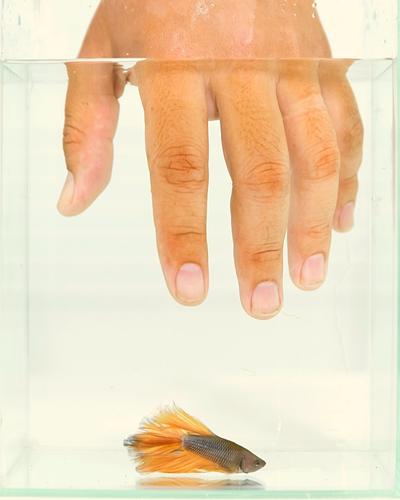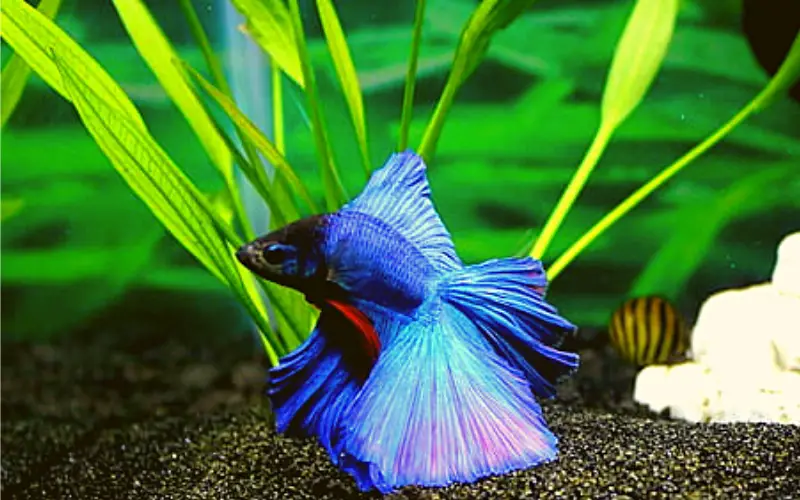If you’ve noticed your sick betta fish laying bottom on side, it’s natural to feel concerned and wonder what’s wrong. These vibrant, graceful swimmers are known for their energy and beauty, so seeing them inactive at the bottom of the tank can be alarming.
While occasional resting is normal, prolonged periods of lethargy or unusual behavior may indicate an underlying issue that needs attention.
A betta fish lying on the tank floor could be a sign of stress, illness, or even environmental problems. Ignoring these signals could put your fish’s health at risk.
But don’t worry—most causes can be identified and addressed with the right knowledge and care.

In this post, we’ll uncover the five most common reasons your betta might exhibit this behavior and provide practical solutions to help your fish recover.
From understanding their environment to spotting health red flags, you’ll gain all the insights you need to take immediate action and restore your betta’s vitality.
Dive in to learn how you can create the best conditions for your betta fish to thrive again!
Table of Contents
ToggleIs It Normal for My Betta Fish to Lay on the Bottom
It is not uncommon for betta fish to occasionally lay at the bottom of their aquarium, especially when they are resting or feeling secure. However, if your betta fish is lying on the bottom of the tank for extended periods, it may signal underlying issues.
Betta fish, like many tropical fish, require specific water parameters and conditions to thrive. When these conditions are not met, they may exhibit signs of stress or sickness, leading them to stay at the bottom of the tank more often than usual.

Regular monitoring of water quality, including factors such as ammonia, nitrite, and nitrate levels, is essential for maintaining a healthy environment for your betta.
In addition to water quality, tank mates can also influence your betta’s behavior. If your betta feels threatened or overcrowded due to aggressive tank mates or an unsuitable tank setup, it may choose to retreat to the bottom of the tank as a coping mechanism.
It’s important to create a peaceful environment with proper hiding spots and adequate space for your betta to feel safe and secure. If you notice persistent behavior of your betta laying on the bottom, it is essential to investigate further and determine the root cause of this unusual behavior.
Why Is My Sick Betta Fish Laying on the Bottom of the Tank?
There are several reasons why your sick betta fish might be laying on the bottom of the tank. One of the primary concerns is poor water quality, which can lead to various fungal infection health issues.
High levels of ammonia, nitrite, or nitrate can severely affect your betta’s health, causing it to exhibit unusual behavior such as staying at the bottom of the tank. Performing regular water changes is vital to ensuring that your betta fish has a healthy living environment.
Checking the water parameters regularly will help you identify any imbalances that could be causing stress or illness in your fish.
Another common reason for this behavior is swim bladder disease, which affects the fish’s buoyancy and can cause it to struggle to maintain its position in the water. If your betta fish is laying on its side at the bottom, it may be suffering from this condition.
Other symptoms of swim bladder disease include loss of appetite and difficulty swimming. In such cases, it’s crucial to assess your betta’s diet and environment to provide the necessary care and treatment.
Additionally, fin rot, a bacterial infection affecting the fins, can also lead to lethargy and unusual positioning, further emphasizing the need for careful observation and prompt action.
The 5 Reasons Sick Betta Fish Laying Bottom on Side
1. Poor Water Quality:
One of the most significant reasons for a sick betta laying on its side is poor water quality. Elevated levels of ammonia or nitrite can cause distress and illness in bettas, leading them to seek refuge at the bottom of the tank. Regular water changes and testing for harmful substances are essential in maintaining a healthy aquarium.
2. Swim Bladder Disease
This condition can cause a betta fish to lose its ability to maintain buoyancy, resulting in the fish laying on its side at the bottom of the tank. It can be triggered by overfeeding, constipation, or poor water conditions. Adjusting the diet and ensuring clean water can help alleviate this issue.
3. Fin Rot:
A sick betta with fin rot may exhibit lethargy and prefer to stay at the bottom of the tank. This bacterial infection can weaken the fish and make it less active. Treatment with aquarium salt and proper water quality can help your betta recover.
4. Stress from Tank Mates:
Aggressive or overly active tank mates can stress your betta, causing it to retreat to the bottom of the tank for safety. Ensure that your betta is housed with compatible tank mates to reduce stress and promote a peaceful environment.
5. Inadequate Tank Size:
A small or overcrowded tank can lead to stress and illness in your betta. A minimum of a 5 gallon tank is recommended to provide ample swimming space and a stable environment. Consider upgrading your tank size and ensuring a proper tank setup to improve your betta’s well-being.
What Does Ammonia Poisoning in Betta Fish Look Like?
Ammonia poisoning is a serious issue that can affect the health of your betta fish and lead to unusual behaviors, such as laying at the bottom of the tank. Symptoms of ammonia poisoning include gasping at the surface, lethargy, loss of appetite, and red or inflamed gills.
If your betta fish is exhibiting these signs, it is essential to test the water for ammonia levels immediately. High ammonia levels indicate that the biological filtration in your aquarium is insufficient or that regular water changes are not being performed adequately.
When ammonia poisoning occurs, it can lead to severe health problems, including organ damage and even death. To remedy this, perform water change to lower the ammonia concentration and improve the overall water quality.
Additionally, consider using ammonia detoxifiers available at pet stores to help neutralize the harmful effects of ammonia while you address the root of the problem.
Regularly monitoring water parameters and maintaining a clean aquarium is vital to prevent ammonia poisoning and ensure the health of your betta fish.
The Ideal pH for Betta Fish Aquarium
The ideal pH level for a betta fish aquarium is typically between 6.5 and 7.5. Maintaining this pH range is crucial for the overall health and well-being of your betta. A pH that is too low or too high can lead to stress and make your betta more susceptible to diseases.
It’s essential to regularly test the water parameters, including pH, to ensure that they remain within the ideal range. If you find that the pH is outside this range, you can use pH adjusters available at pet stores to bring it back to a suitable level.
In addition to pH, other factors such as water temperature and hardness also play a significant role in your betta’s health. Bettas thrive in warmer water temperatures between 76°F and 82°F.
Furthermore, ensuring that your betta has a stable environment free from sudden changes in water conditions is essential for preventing stress and illness. By carefully monitoring and adjusting the pH and other water parameters, you can create a thriving aquarium that supports your betta’s health and happiness.
How Do You Revive a Sick Betta Fish?
Reviving a sick betta fish requires a combination of prompt action and careful observation. First, assess the water quality by testing for ammonia, nitrite, nitrate, pH, and temperature.
If any of these parameters are outside the ideal range, perform a water change and adjust the conditions accordingly. Clean, well-maintained water is crucial for your betta’s recovery.
Additionally, consider isolating your betta in a hospital tank if it is showing severe symptoms, such as laying at the bottom or difficulty swimming.
Once you’ve ensured good water quality, observe your betta for specific symptoms, such as fin rot or swim bladder disease. Depending on the diagnosis, you may need to treat your fish with appropriate medications or aquarium salt.
Adjusting your betta’s diet to include high-quality, easily digestible foods can also help in its recovery. Providing a stress-free environment, including hiding spots and a calm atmosphere, can further aid in reviving your sick betta fish.
Sick Betta Fish Laying Bottom Treatment
Treating a sick betta fish that is laying at the bottom of the tank involves identifying the underlying cause of its behavior. If the issue is related to poor water quality, performing regular water changes and testing for harmful substances like ammonia and nitrite is paramount.
It’s advisable to replace 25-50% of the tank water weekly to maintain a healthy environment. If your betta exhibits signs of illness, such as fin rot or swim bladder issues, specific treatments are necessary.
For fin rot, using aquarium salt and anti fungal medications can promote healing, while swim bladder disease may require dietary adjustments and a temporary fasting period.
Additionally, consider the emotional well-being of your betta fish. If stress from aggressive tank mates or improper tank setup is suspected, re-evaluating the tank configuration can help.
Providing ample hiding spots and ensuring compatibility among tank mates can reduce stress and encourage your betta to swim more freely rather than staying at the bottom.
Monitor your fish closely for any changes in behavior and adjust your care routine accordingly to promote recovery and improve its quality of life.
Conclusion
Understanding why your betta sick on bottom of tank is crucial for providing appropriate care and treatment. By recognizing the various factors that contribute to this behavior, such as poor water quality, swim bladder disease, and stress from tank mates, you can take meaningful steps to improve your betta’s health. Regular water changes, monitoring water parameters, and creating a suitable tank environment are essential for the well-being of your betta fish. If your betta continues to exhibit unusual behavior despite your efforts, seeking advice from a veterinarian or a knowledgeable pet store can provide additional support. Ultimately, the key to a thriving betta lies in attentive fish care and a commitment to maintaining a healthy and stable aquarium environment.
You might also like
- Why Does Betta Fish Not Eating and Laying at Bottom: 3 Reasons Solved
- Pregnant Betta Fish Bubble Nests: 5 Vital Signs & Caring Tips
- 7 Warning Symptoms of a Dying Betta Fish You Need to Know
- Betta Swim Bladder Disorder: (7 Symptoms & Best Treatment)
- Betta Laying on Side But Not Dead: 3 Causes & Treatment
- How to Tell If My Betta Is Dying: (5 Warning Signs)
- Betta Losing Color and Laying on Bottom of Tank: (Solved)
- What Does a Betta Fish Bubble Nest Look Like: A Surprising Truth!




